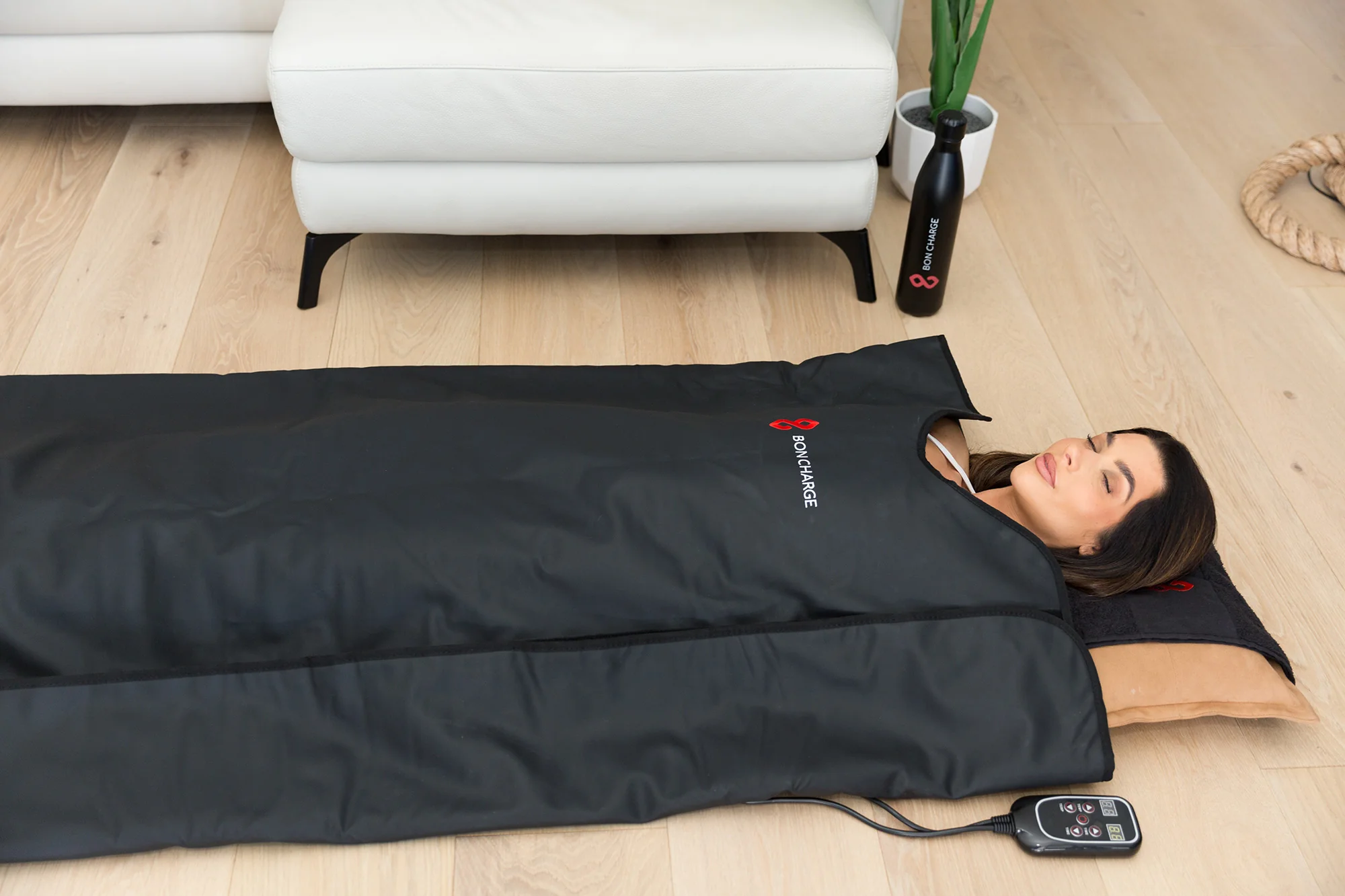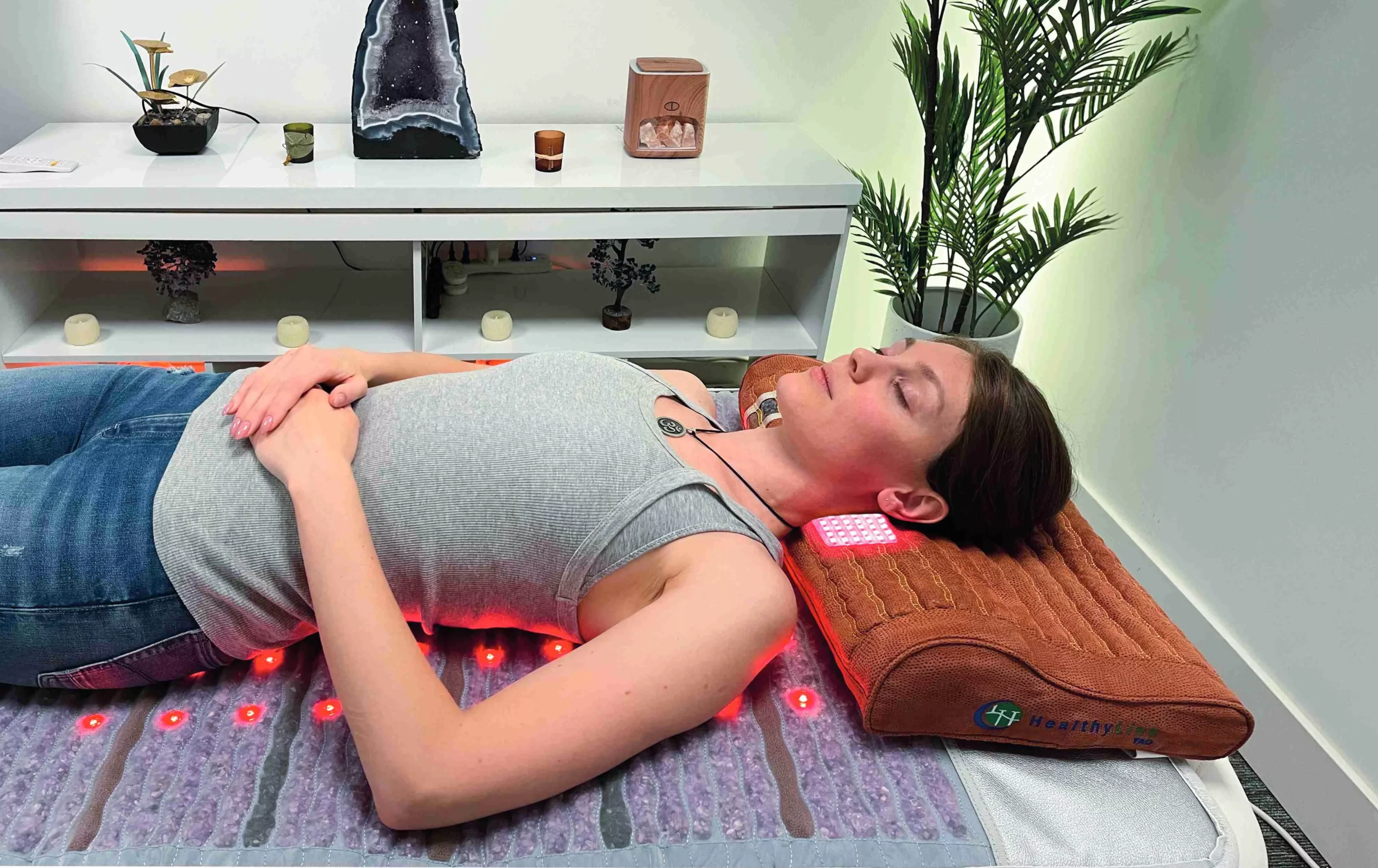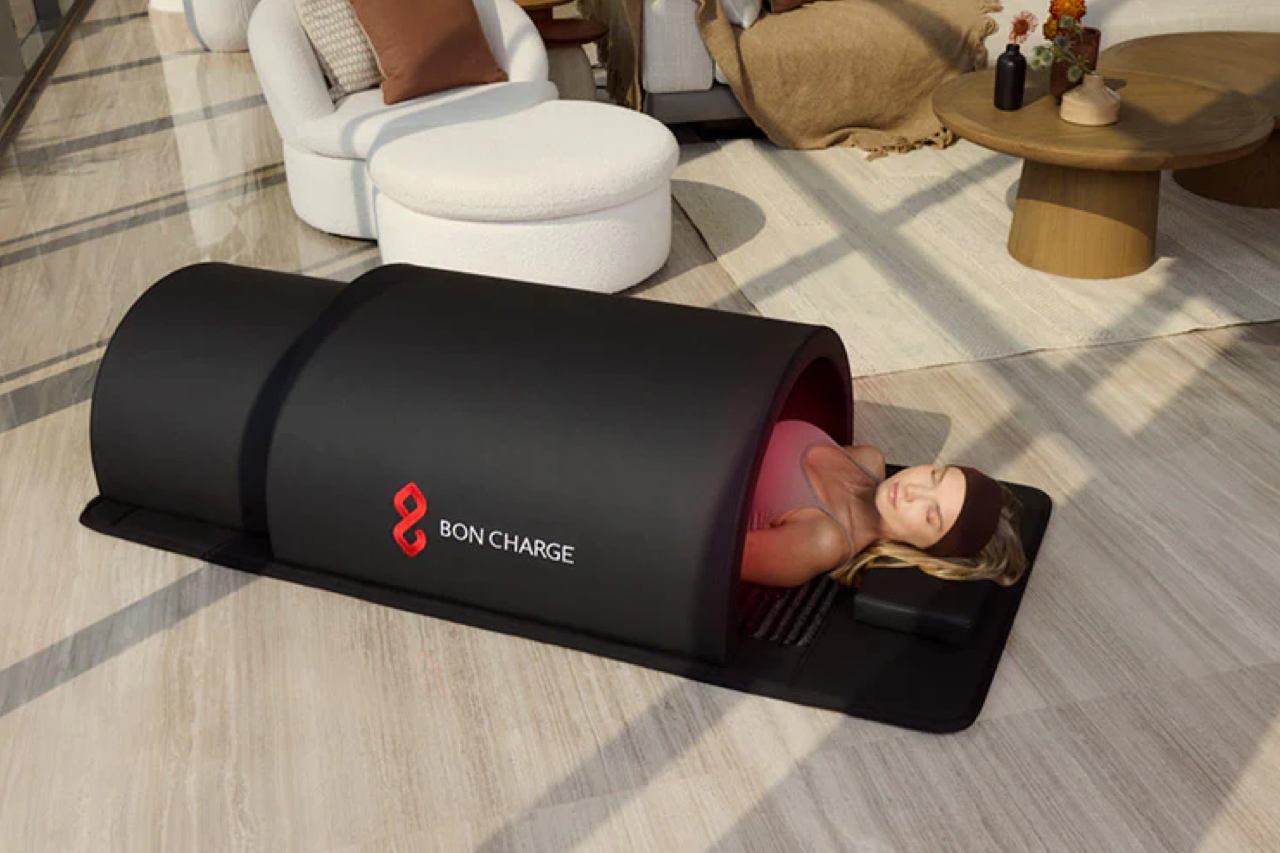- HOME
- Infrared Sauna Benefits
- Neck Pain Relief
Does Infrared Sauna Help Neck Pain?

The possible benefits of infrared sauna for neck pain are gaining recognition as a groundbreaking solution. Chronic neck pain affects approximately 60-70% of people globally at some stage. With around 288 million individuals worldwide suffering from neck pain [1] in 2020, the need for effective and accessible treatments is clear.
Infrared sauna sessions can help, as they offer so much more than relaxation. Their deep-penetrating heat provides an effective approach to reduce the chronic discomfort of neck pain. How does the innovative technology of infrared saunas address the complex nature of neck pain, and how can it play a major role in its management?
A quick tour of the blog post
- Neck pain
- Neck pain management
- Science of infrared sauna
- Research into the effects of infrared therapy for neck pain
- Starting infrared sauna therapy for neck pain management
- The best infrared sauna for neck pain
UNDERSTANDING NECK PAIN
Neck pain ranks among the top five disability causes. Office workers, people over 50, and women experience neck pain more commonly than others.
Many factors, for instance age-related disorders like osteoarthritis and lifestyle habits like lack of exercise, obesity, and prolonged sitting with computers or smartphones, cause neck pain. Emotional stress and severe neck injuries from accidents or falls cause chronic neck pain.
All these different causes result in different physiological manifestations of neck pain, each of which requires a unique management strategy. Neck pain comprises discomfort and pain in the neck, shoulders, upper back, and arms.
Beyond physical soreness, neck aches can also lead to activity limitations, disability, and a serious loss of productivity. This affects both personal and professional lives. Hereby the most common neck pain types:
Mechanical neck pain: Strain or injury to the neck's muscles and ligaments are main causes of this type, and commonly derive from poor posture, repetitive strain, or sudden injuries like whiplash.
Cervical radiculopathy: A pinched or irritated nerve in the neck causes this condition [2]. Causing pain, numbness or tingling that can radiate to the shoulder or arm.

Myofascial pain: A chronic disorder characterized by pressure on sensitive points in the muscles, causing pain in seemingly unrelated parts of the body.
Inflammatory diseases: Conditions such as rheumatoid arthritis or meningitis can lead to neck pain.
Age-related neck disorders: As individuals age, they may experience several neck issues. Cervical spondylosis (neck arthritis) arises from spinal disk wear and tear, leading to stiffness and chronic pain. Osteoarthritis can affect neck joints, causing pain and reducing mobility. Spinal stenosis, involving the narrowing of spinal space, can compress nerves and cause discomfort.
Neck Pain Management
Conventional pain management for neck pain involves personalized treatment such as physical therapy, which focuses on making the neck stronger and more flexible through exercises, heat, ice, and other methods. Medications and therapeutic injections are often used for effective relief.
However, due to a lack of agreement on the best treatment for chronic neck pain, alternative therapies gain prominence. Acupuncture, dry needling, massage therapy, manual manipulation, and mindfulness are becoming more popular over time as complementary treatment options.
In conventional physical therapy for neck pain, heat application is often used to reduce discomfort and improve flexibility. In this context, infrared saunas offer individuals an ideal option for self-care at home.

science behind infrared sauna
Infrared sauna therapy uses infrared waves to directly warm the body’s tissues. They operate at lower temperatures than traditional dry or steam saunas (45°C to 60°C - 110°F to 135°F) and still deliver all the therapeutic benefits.
This method is particularly appealing because it's more comfortable for many users, as they extend a range of health benefits without the intense heat of conventional saunas (65°C to 90°C - 150°F to 195°F).
Recent research suggests that infrared saunas for neck pain may provide valuable benefits in managing neck pain, making it a convenient addition full of promise to current management of neck pain relief.
Recent Studies into Effects Infrared Therapy for Chronic Neck Pain
Therapeutic Effects of Near-infrared Radiation on Chronic Neck Pain
The first study (2013) examined the effects of near-infrared radiation in treating chronic neck pain [3]. 30 participants (20 to 65 years) with chronic neck pain, were divided into two groups.
Group A received near-infrared therapy daily for one week and then no treatment in the second week. Group B had no treatment in the first week and received near-infrared therapy daily in the second week.
Both groups experienced remarkable pain reduction after near-infrared therapy. This increased (showing further improvement) in most muscles after therapy in both groups. No substantial changes were noted in muscle stiffness by this particular study.
The study suggests that near-infrared therapy may alter pain perception and provide some benefits similar to local heat therapy.

The Best Infrared Sauna Blanket Reviews Of 2024
Effects of far-infrared irradiation on neck pain
Another research [4] in 2013 evaluated the effects of far-infrared (FIR) radiation on myofascial neck pain. The study involved 48 people suffering from long-term, muscle-related neck pain. The participants were randomly divided into two groups.
One group used a FIR neck device, while the other group used a fake (placebo) device, both for one week. The researchers measured pain levels, sleep quality, pain threshold, muscle stiffness, and skin temperature.
Both groups, those using the FIR device and the placebo, reported reduced pain. However, there was no substantial difference in pain reduction between the two groups, but the group using the FIR device did report a significant decrease in muscle stiffness in the neck.
A comparison of low dose ultrasound and far-infrared therapies in patients with neck pain
A more recent study from 2020 was a comparison of low dose ultrasound and far-infrared therapy in patients with mechanical neck pain [5]. Involved were 40 women with neck pain, they were divided into two groups.
Group A received ultrasound therapy, and Group B received far-infrared therapy. Both groups also did stretching and strengthening exercises. The treatment lasted 7 weeks. Pain levels were measured before and after the treatments.
After their treatments both groups experienced less pain. Though the far-infrared therapy group had a more noteworthy decrease in pain compared to the ultrasound group. The study suggests that the heat from far-infrared therapy might help reduce pain by improving blood flow and relaxing muscles.

Effects of infrared therapy on pain intensity and neck disability
A 2022 study [6] examined the effectiveness of combining neck stretching (cervical traction) and heat treatment using infrared therapy.
This approach aimed at reducing neck pain and improving neck function in people suffering from cervical spondylosis, a condition that causes wear and tear of the neck's spinal disks.
The researchers found that when people with neck pain from cervical spondylosis used both infrared heat treatment and a specific neck stretching technique for six weeks, their pain decreased far more than when they used only the heat treatment.
They also found that this combination therapy greatly improved the patients' ability to use their necks without discomfort or limitations.
These research findings clearly show that while infrared sauna for neck pain is not a sole treatment option, but an important complementary method within a broader treatment spectrum. It works alongside other conventional and alternative therapies.
Its effectiveness in pain reduction, easing muscle stiffness, and potentially improving neck function makes it a hopeful option for those with conditions like cervical spondylosis and mechanical neck pain.
starting Infrared Sauna therapy for Neck Pain management
Infrared sauna therapy can offer you a complementary way to manage neck pain. It's not just an alternative but a significant part of a broader treatment plan.
Take the first step today and explore how this modern therapy can be part of your neck pain management strategy.
Consult a Healthcare Provider: Before you start, talk to your doctor. Make sure infrared therapy is suitable for your specific condition.
Research Local Options: Look for spas or wellness centers offering infrared sauna services.
Start Slowly: Begin with shorter sessions and gradually increase the duration as your body adjusts.
Stay Hydrated: Drink plenty of water before and after your sauna sessions.
Monitor Your Body: Pay attention to how your body responds and adjust accordingly.
After exploring local options and understanding how your body responds to infrared therapy, you might consider making it a regular part of your routine. In this case, investing in a home infrared sauna could be a great choice.

Discover the benefits of sauna domes
the best Infrared Sauna for Neck Pain
When selecting an infrared sauna for neck pain, the decision hinges on both your specific pain management needs and your personal preferences. Here, we clarify the benefits of different sauna types, which can greatly influence comfort and effectiveness for neck pain relief.
sauna cabins
Cabin saunas, expecially the larger ones, are perfect if you have room and budget for a permanent installation. Their ample space not only allows for multiple users but also facilitates gentle physical exercises that can enhance flexibility and alleviate pain.
These are suitable for both indoor and outdoor settings and are especially beneficial for conditions like neck pain, where lying down helps relieve spinal pressure.
Sauna Tents and Domes
If you need a balance between functionality and convenience, consider sauna tents and domes. These units offer more flexibility than cabin saunas as they can be dismantled and stored away.
There are some domes serving dual functions like acting as a side table when not in use. They provide a good compromise for those with limited space who still want the option to lie down occasionally.
Sauna Blankets
For when you prioritize portability and budget, sauna blankets are an excellent choice. Weighing about 20 pounds, they're easy to transport and store, making them ideal for frequent travelers or those with restricted space.
Sauna blankets allow you to lie down during sessions, which can be particularly beneficial for alleviating neck pain as it lets the muscles relax more thoroughly than sitting positions.
PEMF mats
For an enhanced therapeutic experience, PEMF mats combine infrared heat with pulsed electromagnetic fields, offering dual therapy modes. Some mats also integrate TENS [7] for targeted pain relief.
These full-body mats are heavier (around 40 pounds) and best suited for a fixed location, where they can help improve nighttime rest and overall muscle relaxation, key components in managing chronic pain.
Choose the option that best suits your lifestyle and needs. More detailed information and product reviews are available on our website to help guide your choice.
With the right strategy, infrared therapy can be a game-changer in managing your neck pain.

Sam Everhart
References
1. Somaye Kazeminasab et al., Neck pain: global epidemiology, trends and risk factors, in: BMC Musculoskeletal Disorders, https://bmcmusculoskeletdisord.biomedcentral.com/articles/10.1186/s12891-021-04957-4
2. Mayo Clinic, Pinched Nerve, https://www.mayoclinic.org/diseases-conditions/pinched-nerve/symptoms-causes/syc-20354746
3. Shih-Ching Chen et al., Therapeutic Effects of Near-infrared Radiation on Chronic Neck Pain, Journal of Experimental & Clinical Medicine, https://www.sciencedirect.com/science/article/abs/pii/S187833171300079X
4. Chien-Hung Lai et al., Effects of far-infrared irradiation on myofascial neck pain: a randomized, double-blind, placebo-controlled pilot study, PubMed, https://pubmed.ncbi.nlm.nih.gov/24152215/
5. Marwa Hany et al., A comparison of low dose ultrasound and far-infrared therapies in patients with mechanical neck pain, Journal of the Pakistan Medical Association, https://www.researchgate.net/publication/348869057
6. Augustine ASIDUBA Igwe et al., Effects of cervical traction and infrared therapy on pain intensity and neck disability index among people with cervical spondylosis: a cross-over cohort study, Journal of Musculoskeletal Research, https://www.researchgate.net/publication/362047797
7 Cleveland Clinic, Transcutaneous Electrical Nerve Stimulation (TENS), https://my.clevelandclinic.org/health/treatments/15840-transcutaneous-electrical-nerve-stimulation-tens
Curious for more? These additional articles await


